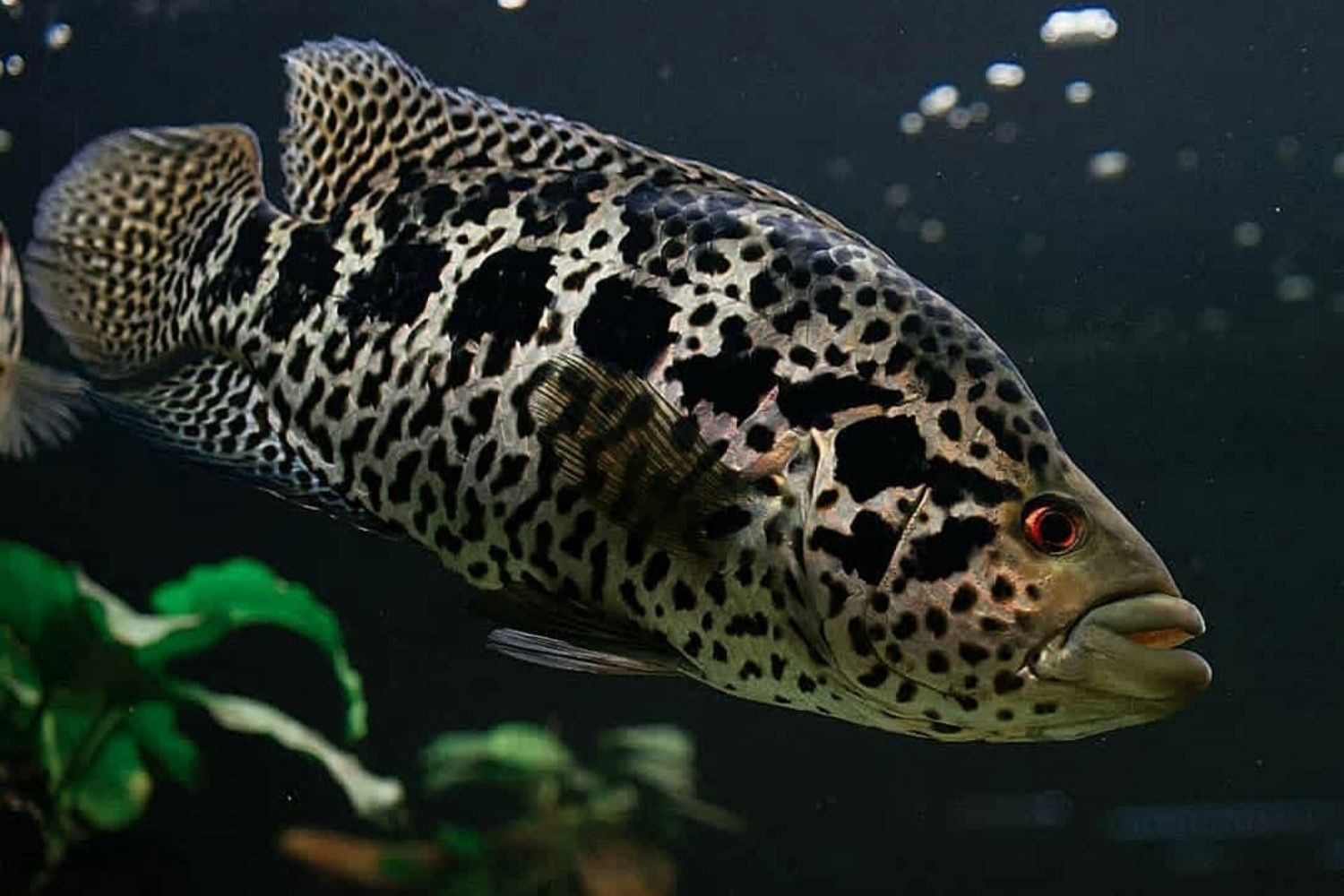Jaguar Cichlid is a wonderful fish to have in your tank, but for sure, you must do some little research if you are planning to do so. It is not simple to take care of this fish, starting with its aggressivity, being territorial and large. However, they’re beautiful, uniquely colored fish like the name itself, Jaguar.
This is the complete Care guide and everything else you should know for Jaguar Chilchlids, starting with the lifespan, tank mates, breeding, diseases, and other details.
This fish is very beautiful to keep in your tank but is not that easy if you are a beginner. However, this article has everything you need to know about this fish and will help you take care of it.
Overview
These fish have a distinct profile made for hunting, it’s named “Jaguar” not only from their predatory behavior but also the dark sports. The dark spots are usually black or dark brown, reflecting the blue of the water, but their appearance changes while they age. The juveniles have black bands that eventually fade when aging until large splotches appear and give them the Jaguar look.
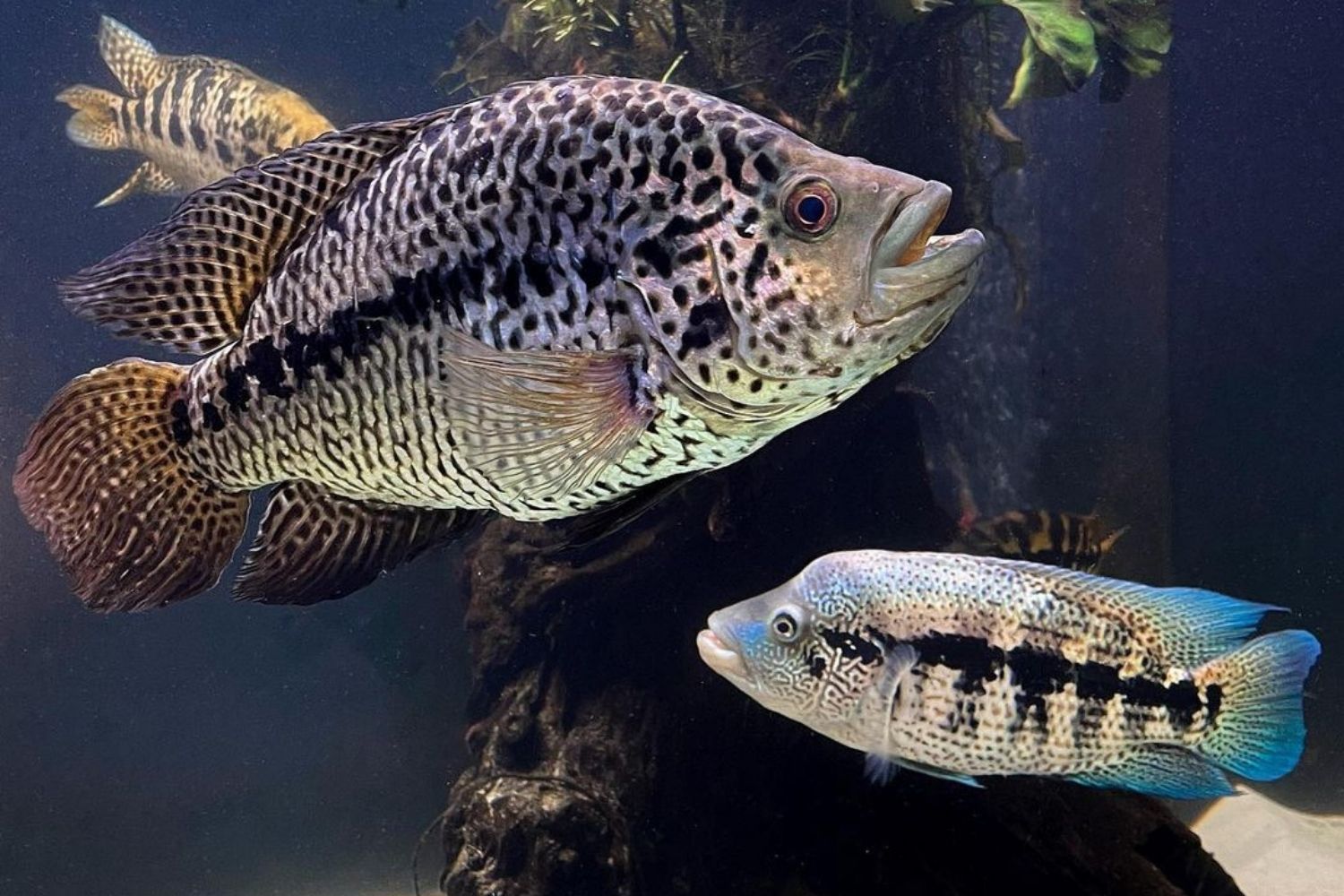
Jaguar Cichlid and Flowerhorn Cichlid can be kept together in same tank.
Their elongated body is oval-shaped and has spiny rays to support the fins that extend from their bodies. Differing from other common fish, Jaguar Cichlid has quite prominent dorsal and tail fins. The spine also gives them a menacing look. The lower jaw that extends beyond the upper jaw a bit also strengthens the aggressive look, also helping for a better hunt having some sharp, quite small teeth.
When talking about size, males are bigger and grow to an average of 16″ (40cm), and females at 13″ (35cm). They have a lifespan of 15 years generally.
| Scientific name | Parachromis Managuensis |
| Origin | Central America |
| Size | Male 16″ (40cm), female 13″ (35cm) |
| Diet Type | Carnivore |
| Substrate | Small gravel |
| Lighting | Moderate – normal lighting |
| Temperature | 75.0 to 82.0° F ( 23.9 to 27.8° C ) |
| pH | 7.0 – 8.7 |
| Hardness | 10 – 15 dGH |
| Minimum tank size | 125 gal (473 l) |
Behavior & Temperament
As we said earlier, Jaguar Cichlid is predatory fish. They will eat smaller critters and fight with the tankmates including smaller fish and invertebrates. They do not stand fish in their space and are very territorial. They’re quite active and will swim in the middle-bottom of the tank! It was hard for us to keep this fish in our aquarium. We kept it together with other cichlids fish like Jack Dempsey Cichlid and Firemouth Cichlid.
Origin & Habitat
Jaguar Cichlid originates from Central America. They live in freshwater, lakes, and basins throughout various countries. They are mainly found in Nicaragua, Honduras (Ulua River), and Costa Rica.
The wild Jaguar Cichlid becomes large enough for human consumption in their native lands. They are also known as Managuense Cichlid, Jaguar Guapote, Managua Cichlid, Aztec Cichlid, Spotted Guapote, and Tiger Guapote.
Their favorite habitat is turbid waters with muddy bottoms in warm, low-oxygenated ponds and lakes.
Food & Diet
Is paramount to provide Jaguar Cichlid with a healthy diet. This will keep them healthy and manage their aggression. This fish is highly carnivorous. At a young age, they can be trained to eat flakes and pellets (you can use an automatic fish feeder to minimize the work), but a protein-based diet is also the best.
Some of the food may be:
- Feeder fish
- Crickets
- Insects
- Ghost shrimp
- Worms, bloodworms, blackworms, mealworms,
- Dry and frozen food
- Small frogs
- Everything that fits their mouth.
The variety of food is essential.
Be careful when feeding them by hand, though. They can bite you.
Things To Avoid
Be careful with fish food bought from pet stores because they might introduce diseases into the tank and ill the fish. Also, don’t feed them meaty foods, any animal meats used for humans will make them ill. Beef heart is denied as well for the same reason. Therefore, overfeeding is never a good idea. Daily feeding is the best feeding frequency.
Care & Tank Requirements
You should be careful with Jaguar Cichlid and secure your tank with a tight-fitting lid, as they can jump out of the tank. Therefore you should be careful with the water conditions, hardness, and ph level. They are very sensitive to the instability of water, a high level of hardness but yet not too much as it may be harmful.

Jaguar Cichlid is predatory fish, you can say that even by look at his appearance.
Therefore, you should be careful with:
- Water conditioners
This fish can suffer from a disease called Ich or White Spot Disease. In this case, copper-based fish medications will help treat it, but it is important to remove water conditioners and use a large simp or canister filter instead. - Nitrates and phosphates
These can build up and increase water hardness. Prolonged exposure to nitrates and phosphates will weaken the fish’s immune system and cause various diseases.
The water in the tank should be changed twice a week. 20-30% of the water would be perfect. This would be a critical problem for the fish and impact its health. Low and subdued lighting would be great. As for the water parameters and tank size, you will find more detailed information below.
Tank Size
The bigger the tank, the best for this fish, as they can grow in large sizes. Therefore, space will help reduce their aggressivity. A large capacity tank of 100 gallons (378 L) is ideal for Jaguar Cichlid.
It is very important for this fish to have its own space since it is very territorial.
Water Parameters
The temperature of the water for these fish should be slightly warm as they are from a tropical climate. The best water temperature range for Jaguar Cichlid is 74-79° F (24-28° C). They live in freshwater, with a pH level of 7.0-8.7 and water hardness of 10 – 15 dGH. They produce a lot of waste, and it is important to ensure a powerful filter in order to maintain the tank.
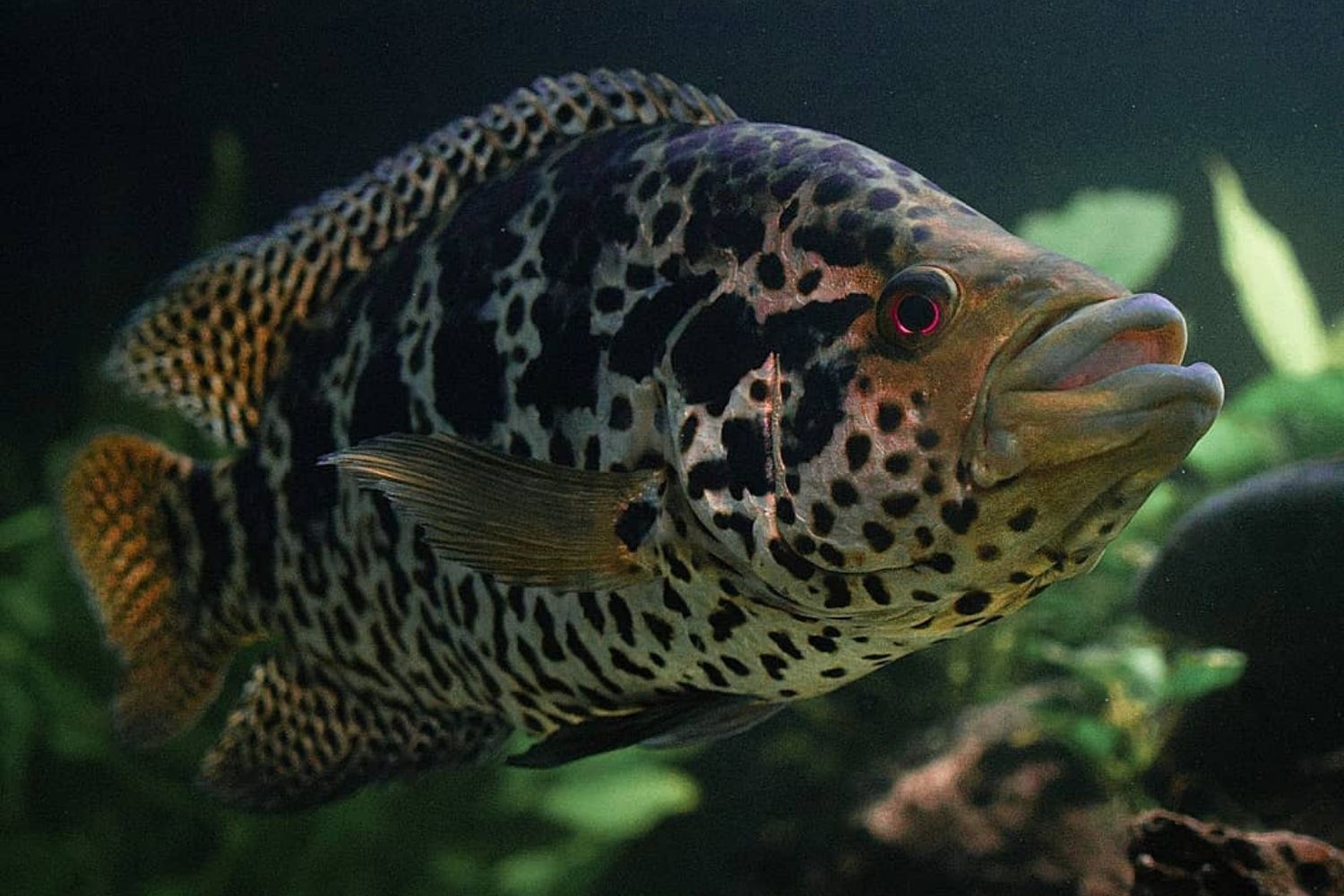
Jaguar Cichlid can grow around 14-16 inches.
Breeding
Jaguar Cichlid naturally pairs off and is not difficult to breed. Therefore, they make very great parents. They are very protective of their eggs and fry. Females, in this case, will exhibit maternal behaviors and take care of the tiny fry as they grow up.
You should keep an eye on their behavior if they share the tank with other fish. They start being more aggressive than normal when they attempt to breed, and that would be the perfect time to replace them with a larger tank, separated from other fish.
The breeding process can be triggered with these steps:
- Raising the temperature a few degrees
- Make sure to make 50 percent water changes a couple of times a week.
- Provide plenty of quality food.
Females will find a flat rock or cave to lay eggs. They can lay upwards of 2,000 orange eggs at once, and the male will make the fertilization of the eggs. It takes 5 to 7 days for them to hatch. Until that moment, the female will stay close by, and the males will be the ones to protect the area.
The male would fight to the death to protect the eggs. That are why they should be separated from other fish. After hatching, the tiny fry will be transferred to a pit in the sand and won’t swim freely until they’re a week old. In this case, baby brine shrimp is recommended for food until they’re juveniles and ready to feed as their parents.
Sex Difference
Young Jaguar Cichlid has several dark bars, two dark bars behind the eyes, one running horizontally, and another running diagonally to the gill cover.
Mature males do not have these bars as they develop a ‘jaguar’ patterning. The adult female bars may or may not display. They tend to have a line of large black dots across the body. Males grow up to 16″ (40 cm), and females are slightly smaller in size, to about 14″ (36 cm).
The male generally has more color than the female and is bigger in size with longer and pointed dorsal and anal fins. The females are more rounded and stay lower in the aquarium. Males have a higher growth rate compared to females.
Therefore, the males are more aggressive during breeding as they tend to protect the eggs.
Diseases associated with Jaguar Cichlid
Like all other freshwater fish, the Jaguar Cichlid may also develop common fish diseases. Infection is a common Ich or white spot disease (it is caused by a protozoan called Ichthyophthirius multifiliis). The White spot disease can be treated by raising the temperature for three days to about 80° F. If this doesn’t work, the fish should be treated with copper under the instructions of the copper manual.
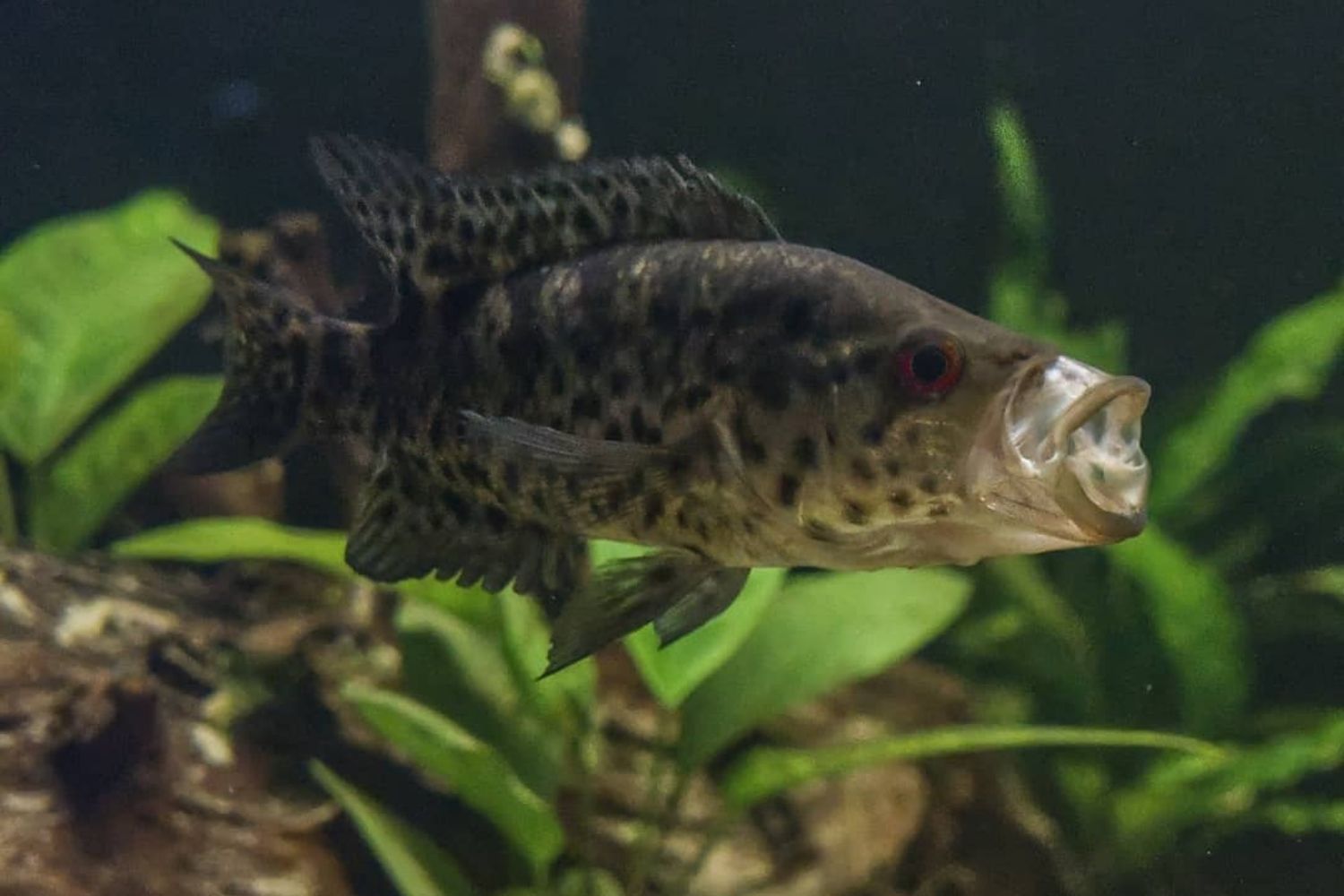
A closer look at Jaguar Cichlid teeth.
For intestinal diseases, Metronidazole would work great. Feeder fish from pet stores are also dangerous. Jaguar Cichlid is sensitive and can get ill to skin flukes and other parasitic, fungal, and bacterial infestations. This is why cleanliness plays an important role in their health.
For experienced fish-keepers, Jaguar Cichlid can be really fun. It is difficult to define which are the females and males; that’s why you should purchase several juveniles in order to make a pair. It is important to purchase this fish from different sources because we want to avoid buying siblings. Interbreeding can generate various genetic diseases. Therefore, to avoid breeding fish of different ages, we highly recommend buying fish of similar size.
Tank Mates
As Jaguar Cichlid is considered an aggressive fish, we can clearly say that it is not a compatible community fish when it comes to sharing its tank with other fish. A breeding pair of Jaguar Cichlid may be very dangerous, as mating pairs kill fish to protect their eggs. However, there are some fish that can be tankmates with these predators.
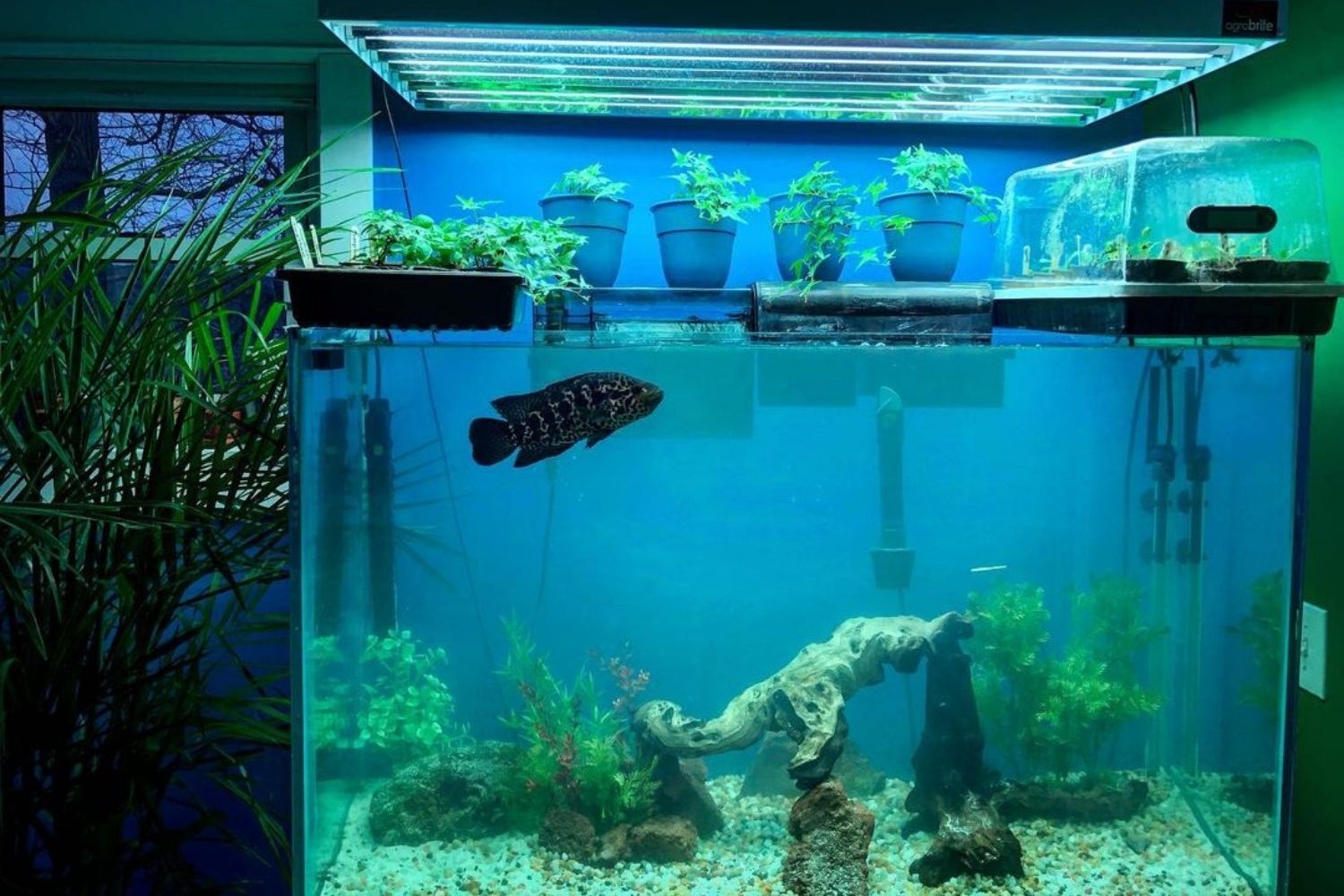
We keep Jaguar Cichlid alone or with other Cichlid fish.
When choosing the tankmates for your Jaguar Cichlid, you need to be selective, cautious, and monitor your fish closely, especially if the Jaguar pair is breeding. Make sure you don’t choose to share the tank of the Jaguar Cichlid with small fish. In any case, you will need a large-sized tank.
Jaguar Cichlid is a fish that requires a lot of space and is very territorial. You should choose companions that are larger than the Jaguar in size. If you raise together with other large, aggressive Cichlids, the amount of conflict will lower.
This is the recommended list of ideal tankmates:
- Oscar Fish
- Convict Cichlid
- Red Devil Cichlid
- Green Terror Cichlid
- Flowerhorn Cichlid
- Jack Dempsey Cichlid
- Peacock Cichlid
Conclusion
Jaguar Cichlid is a great choice for experienced aquarium enthusiasts who know to deal with aggressive fish. This fish is not recommended for beginners, as they have predatory behavior, are territorial, large, and want a lot of space. This makes this type of fish very hard to find tank mates. Therefore, this is a very beautiful fish. Its exceptional colors and patterns, similar to Jaguar, will enhance the beauty of your tank.
